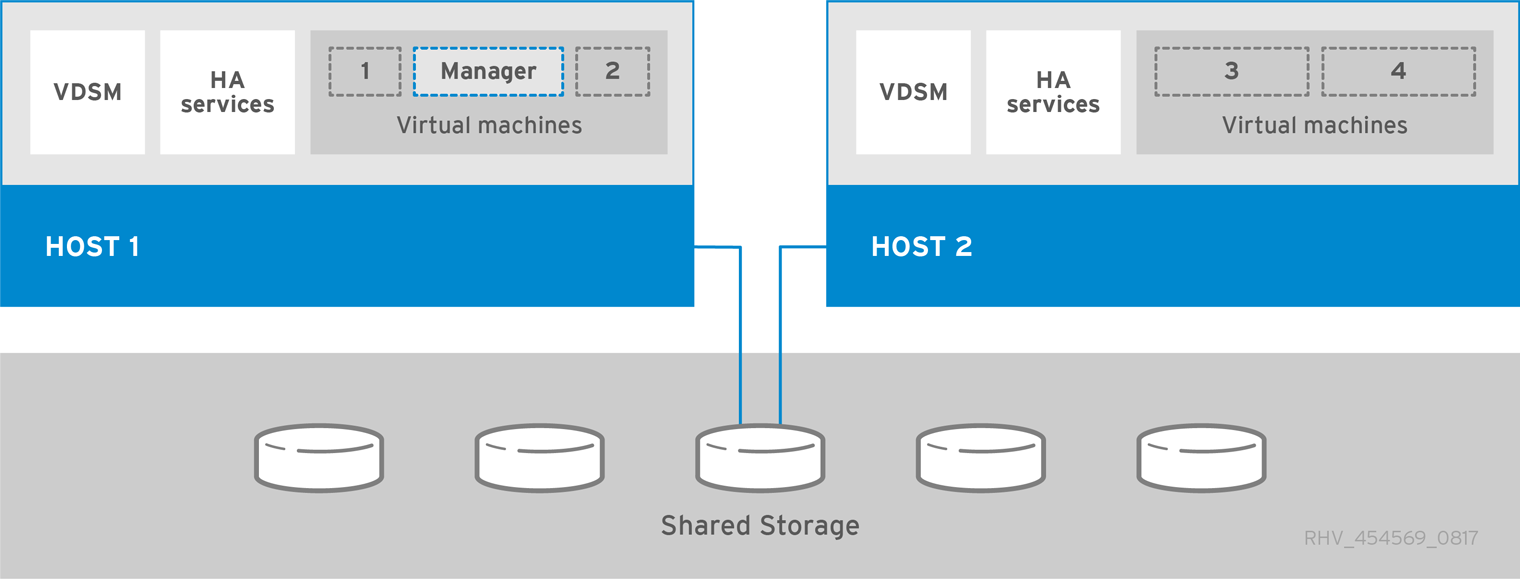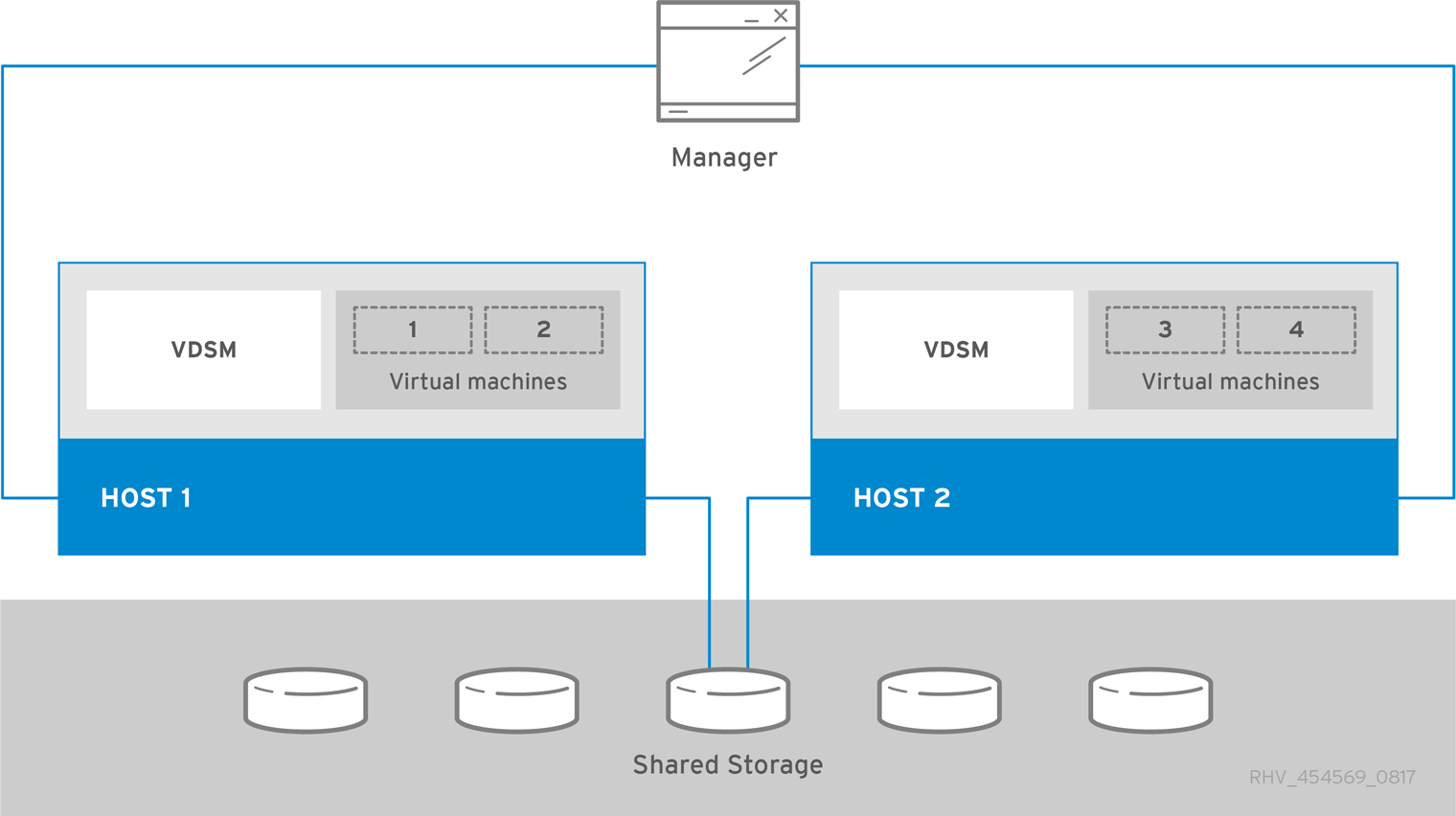Ce contenu n'est pas disponible dans la langue sélectionnée.
Chapter 1. Introduction to Red Hat Virtualization
Red Hat Virtualization is an enterprise-grade virtualization platform built on Red Hat Enterprise Linux. Virtualization allows users to easily provision new virtual servers and workstations, and provides more efficient use of physical server resources. With Red Hat Virtualization, you can manage your entire virtual infrastructure - including hosts, virtual machines, networks, storage, and users - from a centralized graphical user interface or REST API.
1.1. Red Hat Virtualization Key Components
| Component Name | Description |
|---|---|
| Red Hat Virtualization Manager | A service that provides a graphical user interface and a REST API to manage the resources in the environment. The Manager is installed on a physical or virtual machine running Red Hat Enterprise Linux. |
| Hosts | Red Hat Enterprise Linux hosts (RHEL hosts) and Red Hat Virtualization Hosts (image-based hypervisors) are the two supported types of host. Hosts use Kernel-based Virtual Machine (KVM) technology and provide resources used to run virtual machines. |
| Shared Storage | A storage service is used to store the data associated with virtual machines. |
| Data Warehouse | A service that collects configuration information and statistical data from the Manager. |
For detailed technical information about Red Hat Virtualization, see the Technical Reference.
1.2. Red Hat Virtualization Architecture
Red Hat Virtualization can be deployed as a self-hosted engine, or as a standalone Manager. A self-hosted engine is the recommended deployment option.
1.2.1. Self-Hosted Engine Architecture
The Red Hat Virtualization Manager runs as a virtual machine on self-hosted engine nodes (specialized hosts) in the same environment it manages. A self-hosted engine environment requires one less physical server, but requires more administrative overhead to deploy and manage. The Manager is highly available without external HA management.
The minimum setup of a self-hosted engine environment includes:
- One Red Hat Virtualization Manager virtual machine that is hosted on the self-hosted engine nodes. The RHV-M Appliance is used to automate the installation of a Red Hat Enterprise Linux 9 virtual machine, and the Manager on that virtual machine.
- A minimum of two self-hosted engine nodes for virtual machine high availability. You can use Red Hat Enterprise Linux hosts or Red Hat Virtualization Hosts (RHVH). VDSM (the host agent) runs on all hosts to facilitate communication with the Red Hat Virtualization Manager. The HA services run on all self-hosted engine nodes to manage the high availability of the Manager virtual machine.
- One storage service, which can be hosted locally or on a remote server, depending on the storage type used. The storage service must be accessible to all hosts.
Figure 1.1. Self-Hosted Engine Red Hat Virtualization Architecture
1.2.2. Standalone Manager Architecture
The Red Hat Virtualization Manager runs on a physical server, or a virtual machine hosted in a separate virtualization environment. A standalone Manager is easier to deploy and manage, but requires an additional physical server. The Manager is only highly available when managed externally with a supported High Availability Add-On.
The minimum setup for a standalone Manager environment includes:
- One Red Hat Virtualization Manager machine. The Manager is typically deployed on a physical server. However, it can also be deployed on a virtual machine, as long as that virtual machine is hosted in a separate environment. The Manager must run on Red Hat Enterprise Linux 9.
- A minimum of two hosts for virtual machine high availability. You can use Red Hat Enterprise Linux hosts or Red Hat Virtualization Hosts (RHVH). VDSM (the host agent) runs on all hosts to facilitate communication with the Red Hat Virtualization Manager.
- One storage service, which can be hosted locally or on a remote server, depending on the storage type used. The storage service must be accessible to all hosts.
Figure 1.2. Standalone Manager Red Hat Virtualization Architecture
1.3. Red Hat Virtualization Terminology
- Cluster - A cluster is a set of physical hosts that are treated as a resource pool for virtual machines. Hosts in a cluster share the same network infrastructure and storage. They form a migration domain within which virtual machines can be moved from host to host.
- Data Center - A data center is the highest level container for all physical and logical resources within a managed virtual environment. It is a collection of clusters, virtual machines, storage domains, and networks.
- Events - Alerts, warnings, and other notices about activities help the administrator to monitor the performance and status of resources.
-
HA Services - The HA services include the
ovirt-ha-agentservice and theovirt-ha-brokerservice. The HA services run on self-hosted engine nodes and manage the high availability of the Manager virtual machine. - High Availability - High availability means that a virtual machine is automatically restarted if its process is interrupted, either on its original host or another host in the cluster. Highly available environments involve a small amount of downtime, but have a much lower cost than fault tolerance, which maintains two copies of each resource so that one can replace the other immediately in the event of a failure.
- Host - A host, or hypervisor, is a physical server that runs one or more virtual machines. Hosts are grouped into clusters. Virtual machines can be migrated from one host to another within a cluster.
- Host Storage Manager (HSM) - Any non-SPM host in the data center that can be used for data operations, such as moving a disk between storage domains. This prevents a bottleneck at the SPM host, which should be used for shorter metadata operations.
- Logical Network - A logical network is a logical representation of a physical network. Logical networks group network traffic and communication between the Manager, hosts, storage, and virtual machines.
- Remote Viewer - A graphical interface to connect to virtual machines over a network connection.
- Self-Hosted Engine Node - A self-hosted engine node is a host that has self-hosted engine packages installed so that it can host the Manager virtual machine. Regular hosts can also be attached to a self-hosted engine environment, but cannot host the Manager virtual machine.
- Snapshot - A snapshot is a view of a virtual machine’s operating system and all its applications at a point in time. It can be used to save the settings of a virtual machine before an upgrade or before installing new applications. In case of problems, a snapshot can be used to restore the virtual machine to its original state.
- Storage Domain - A storage domain is a logical entity that contains a standalone image repository. Each storage domain is used to store virtual disks or ISO images, and for the import and export of virtual machine images.
- Storage Pool Manager (SPM) - The Storage Pool Manager (SPM) is a role assigned to one host in a data center. The SPM host has sole authority to make all metadata changes for the data center, such as the creation and removal of virtual disks.
- Template - A template is a model virtual machine with predefined settings. A virtual machine that is based on a particular template acquires the settings of the template. Using templates is the quickest way of creating a large number of virtual machines in a single step.
- VDSM - The host agent service running on the hosts, which communicates with the Red Hat Virtualization Manager. The service listens on TCP port 54321.
- Virtual Machine - A virtual machine is a virtual workstation or virtual server containing an operating system and a set of applications. Multiple identical virtual machines can be created in a Pool. Virtual machines are created, managed, or deleted by power users and accessed by users.
- Virtual Machine Pool - A virtual machine pool is a group of identical virtual machines that are available on demand by each group member. Virtual machine pools can be set up for different purposes. For example, one pool can be for the Marketing department, another for Research and Development, and so on.

